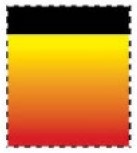Court of Appeals for the Federal Circuit Expands Protection of Multicolor Product Packaging Marks
On April 8, 2020, in an appeal from the refusal of a trademark application, the Federal Circuit held that a multicolor product packaging mark can be inherently distinctive, and might be registerable without proof of acquired distinctiveness—even if the multicolor mark is not associated with a distinctive peripheral shape or border. In re Forney Industries, Case No. 19-1073 (Fed. Cir. Apr. 8, 2020). This ruling potentially expands the ability of trademark applicants to register color marks as applied to packaging, even without proving acquired distinctiveness (or secondary meaning), i.e., without proving that the claimed mark has been used extensively so as to be recognized among purchasers as source-identifying.
The matter arose in 2014 when applicant Forney filed a trademark application for its proposed "color mark" for packaging for various welding and machining goods. Forney sought to register the mark without a showing of acquired distinctiveness, arguing that the proposed mark was inherently distinctive and did not require proof of use and recognition among purchasers. The mark was described as consisting of "a solid black stripe at the top. Below the solid black stripe is the color yellow which fades into the color red. These colors are located on the packaging and or labels." The mark was surrounded in dotted lines, meaning that it was not limited to a particular shape or border.

The USPTO examining attorney refused registration on the ground that the mark was not inherently distinctive, and that color marks "are registrable only on the Supplemental Register or on the Principal Register with sufficient proof of acquired distinctiveness."
Forney appealed this decision to the Trademark Trial and Appeal Board (the Board), arguing that its proposed mark should be treated as product packaging claiming multiple colors. The Board relied on the Supreme Court's decisions in Two Pesos, Inc. v. Taco Cabana, Inc., 505 U.S. 763 (1992), Qualitex Co. v. Jacobson Prod. Co., 514 U.S. 159 (1995), and Wal-Mart Stores, Inc. v. Samara Bros., 529 U.S. 205 (2000), to hold that when assessing marks consisting of color, there is no distinction between colors applied to products and colors applied to product packaging. The Board ultimately held that Forney's mark was not inherently distinctive for two reasons: (1) a color mark can never be inherently distinctive, even in the trade dress context and (2) (presumably in the alternative), even if a color mark could be inherently distinctive, it cannot be inherently distinctive unless it is presented in a well-defined peripheral shape or border.
Reversing this decision, the Federal Circuit held that the Board erred in two ways: (1) by concluding that a color-based trade dress mark can never be inherently distinctive without differentiating between product design and product packaging marks; and (2) by concluding that a multicolor product packaging mark cannot be inherently distinctive in the absence of an association with a well-defined peripheral shape or border.
On the first point, the Court of Appeals explained that the Supreme Court's discussion of color marks in Qualitex and Wal-Mart addressed color marks as applied to products, not packaging. (Qualitex, for example, involved a particular color as applied to a product itself, and the court noted that Wal-Mart's discussion of Qualitex was itself in the context of a product design mark, not a packaging case.) The Court of Appeals held that color marks can be inherently distinctive when used on product packaging, depending upon the character of the color mark, explaining that a distinct color-based product packaging mark can indicate the source of the goods to a consumer, and, therefore, can be inherently distinctive even without proof of the extent of use of the mark or of recognition among purchasers. The court's holding was consistent with the Tenth Circuit's holding in Forney Industries, Inc. v. Daco of Missouri, Inc., 835 F.3d 1238, 1248 (10th Cir. 2016), that the use of color in product packaging can be inherently distinctive (so that it is unnecessary to show secondary meaning) in appropriate circumstances.
On the second point, the Court of Appeals noted that the Board had no explanation for its alternative holding that a color mark may only be inherently distinctive when used in conjunction with a distinctive peripheral shape or border, and held that no case law mandated such a rule.
Because acquired distinctiveness is not required for a multicolor product packaging mark, the Court of Appeals explained that the question to be answered is whether the trade dress "makes such an impression on consumers that they will assume" the trade dress is associated with a particular source. To assess that question, the Board must look to the well-settled factors that are used for applications to register packaging configuration marks, from Seabrook Foods, Inc. v. Bar-Well Foods Ltd., 568 F.2d 1342, 1344 (C.C.P.A. 1977): (1) whether the trade dress is a "common" basic shape or design; (2) whether it is unique or unusual in the particular field; (3) whether it is a mere refinement of a commonly-adopted and well-known form of ornamentation for a particular class of goods viewed by the public as a dress or ornamentation for the goods; or, inapplicable here, (4) whether it is capable of creating a commercial impression distinct from the accompanying words.
In light of the court's decision in Forney Industries, brand owners should assess whether this ruling opens up opportunities to protect additional aspects of their existing or new product packaging trade dress, without a need to show of acquired distinctiveness. As the court of Appeals held, such marks potentially can be inherently distinctive under the Seabrook factors, regardless of the extent of use of the design or proof of recognition among purchasers.
© Arnold & Porter Kaye Scholer LLP 2020 All Rights Reserved. This Advisory is intended to be a general summary of the law and does not constitute legal advice. You should consult with counsel to determine applicable legal requirements in a specific fact situation.


